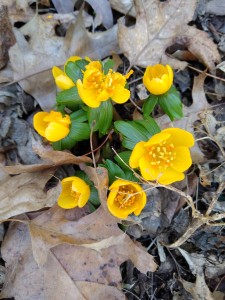 Sometimes people see things in my garden that they don’t expect, like neatness, an absence of weeds and crisply clipped hedges. In the fall, I often notice looks of astonishment on the faces of the local dog walkers—who keep close tabs on the front garden—when they notice fall-blooming crocuses springing up just as the asters are dying down. Those dog walkers can’t see the back garden, but if they did, they would be amazed by the golden-orange buttercups now on display under one of the hydrangea bushes.
Sometimes people see things in my garden that they don’t expect, like neatness, an absence of weeds and crisply clipped hedges. In the fall, I often notice looks of astonishment on the faces of the local dog walkers—who keep close tabs on the front garden—when they notice fall-blooming crocuses springing up just as the asters are dying down. Those dog walkers can’t see the back garden, but if they did, they would be amazed by the golden-orange buttercups now on display under one of the hydrangea bushes.
My “buttercup” is in fact a winter aconite or Eranthis cilicica. The resemblance is not coincidental, as winter aconite is a member of the large Ranunculaceae or buttercup family. Its buttercup relatives, the hellebores, are in various stages of awakening across the garden, but the delicate-looking little flowers have them beaten by a mile. My aconite goes by the varietal name ‘Orange Glow’. The “glow” is real, though the orange is more a suggestion than a dominant color.
Eranthis cilicica and its more common relative, Eranthis hyemalis, are low growers, reaching no more than six inches in height, with an equal spread. The little buttercups, which are yellow in the hyemalis species and may be yellow or golden-orange in the cilicica types, appear at the tops of the short stalks, surrounded by a ruff of green bracts. The true leaves, which sprout at the plants’ bases, come after the flowers are gone, and the entire plant disappears as early spring advances to mid spring.
Eranthis have flowered for centuries in their native areas—Western Europe, from southern France to Bulgaria, for hyemnalis, and Turkey, Kurdistan, Iran and Afghanistan for the cilicica species. It is unclear when cilicica aconites arrived in England, but the more common Eranthis hyemalis were first mentioned by the celebrated English herbalist John Gerard in his Catalogue, published in 1596, during the reign of the first Queen Elizabeth. At least one eranthis plant list mentions that ‘Orange Glow’ was first discovered in a Copenhagen, Denmark botanical garden. It was probably a random seedling of another cilicica plant. American listings for ‘Orange Glow’ are not plentiful. As with many other plants—especially specimens that I develop crushes on—‘Orange Glow’ seems to be much more popular and available in Great Britain and Europe than it is here.
Fortunately I did not have to cross the pond to get one. I received mine from snowdrop guru Hitch Lyman about nine years ago. I don’t believe he has had sufficient stocks to sell it since. European catalog vendors sometimes carry this and other cilicica varieties, like ‘Guinea Gold’, which has yellow-gold flowers and bronzy foliage, and ‘Flore Pleno’, which boasts double yellow buttercups.
We Americans do not have to suffer, however, since the appealing hyemalis species and the more common yellow cilicica type are readily available from bulb specialists. All you have to do is plant the bulbs two to three inches under the soil in the fall in expectation of spring bloom.
Your gardening friends and neighbors may not be privy to the beautiful secret that is winter aconite, but if they are, and you are on good terms, offer to trade a favor or two for a small clump lifted “in the green”, right after bloom time is over. Many experts think that this method is ideal for both winter aconite and snowdrops.
Some references say the plants do best in slightly alkaline soil, but mine have been fruitful and multiplied in the same acid soil that happily supports rhododendrons and azaleas. The original plant from nine years ago has now grown to about ten flowering specimens, which pleases me greatly.
If you start with live plants, give them a bit of water to help them get established. The bulbs, once installed in fall, pretty much take care of themselves. I think the more common types increase even faster than my ‘Orange Glow’ because they set seed very efficiently.
No matter whether you start with bulbs or plants, it’s wise to mark where you installed your winter aconites so you don’t dig them up inadvertently.
You don’t see winter aconite in every garden, but when you do, you are bound to feel better about everything, even if the day is a gray as moles’ fur. As the daylight returns to the landscape, the little golden flowers add just a bit more brightness.
Barring donations from generous neighbors, a good source for winter aconite bulbs is Brent and Becky’s Bulbs, 7900 Daffodil Lane Gloucester, VA 23061; (877) 661-2852; www.brentandbeckysbulbs.com. Print catalog available.
To keep things moist and well insulated, mulch your eranthis, preferably with shredded leaves or other organic material.
